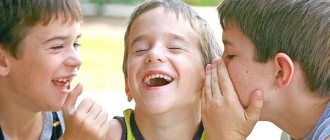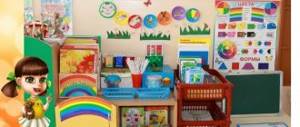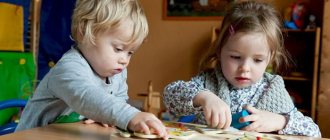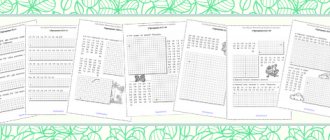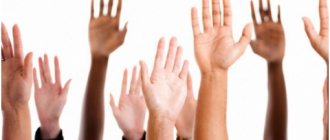Dear Colleagues! Parents! We bring to your attention the section of the site “Diagnostics of mathematical abilities”, which will be very useful to you:
it presents the planned results of mastering the program;
the content of the tasks is closely related to the educational program “Mathematical Steps”;
The methods used for diagnosis make it possible to obtain not only information about the knowledge, skills and abilities that the child has mastered, but also the level of formation of universal prerequisites for educational activities (the ability to listen to an adult and follow his instructions, the ability to conduct self-control and self-assessment of the work performed).
Analyzing the results will allow you to identify areas in which your child is experiencing difficulties and outline ways to eliminate them.
Success in school is not associated with having a large amount of knowledge, skills and abilities, although this is also important.
School education places demands not only on the child’s having a certain stock of knowledge, skills and abilities, but also on the level of development of abilities, in this case mathematical ones.
What is mathematics for a preschooler? What are mathematical abilities in preschool age that will later become the basis for successful schooling?
Mathematics for a preschooler is:
acquiring knowledge about set, number, size, shape, space and time;
familiarization with mathematical dependencies and relationships;
acquisition of skills in initial educational activities: the ability to understand the educational task and carry it out independently;
formation of self-control and self-esteem skills;
mastery of mathematical terminology (number, figure, more-less, plus, minus, equals, geometric figures, centimeter);
development of attention, memory, thinking;
development of graphic skills (writing numbers, drawing geometric shapes).
At the same time, the purpose of education is not only to familiarize children with mathematical concepts, but also to develop their mathematical abilities.
All these problems are solved in preschool educational institutions comprehensively and systematically in classes on the development of mathematical concepts, taking into account the age and individual characteristics of the child. Mathematical concepts are acquired by the child both in the process of becoming familiar with the world around him and during games in free activity. In preschool age, the child begins to develop mathematical abilities, which include a number of particular abilities:
Ability to generalize mathematical material (numbers, figures, signs).
The ability to reversible thought processes (to move from forward to backward movement of thoughts: forward and backward counting, addition and subtraction).
The ability to collapse mathematical reasoning and corresponding mathematical actions (the transition from practical actions with objects to actions in the mind).
The decisive factor that determines whether a child discovers abilities for a given activity or not is the teaching method.
The section includes sections that were presented in the “Mathematical Steps” program: quantity and counting, geometric figures, magnitude, orientation in time and space, logical problems.
Within each section, tasks are grouped into tasks that make up the structure of mathematical abilities.
When selecting diagnostic tasks (tests), we wanted you to see your child as smart, talented, capable, and the child to feel his strength, confidence and readiness for school.
HOW TO WORK WITH SITE MATERIALS
Diagnostics completes the work of forming elementary mathematical concepts.
Don't rush to complete all tasks with your child in one day. If your child is tired or uninterested, take a break.
After the child completes each task, color the ball on the left green if the task was completed correctly, yellow if he made inaccuracies, and red if the task was not completed at all.
Once your child completes all the tasks, fill out the table. To do this, count the number of green balls with symbols and enter the results in the column of the table “how much in fact”. Below the table, read the scores for the results.
Diagnostics of mathematical development of preschool children
Know how to play checkers and chess. Using tasks to find the missing figure, develop logical thinking, resourcefulness, and ingenuity. Be able to explain a familiar route. With the help of the teacher, familiarize yourself with the area plan, diagram map, and scale.
Be aware of time, consciously use units of time (hour, minute, day, week, year). Find your bearings by the clock.
Indicators:
know numbers and signs, be able to use them when solving arithmetic problems;
be able to justify the choice of arithmetic operation;
know some rules of computing; be able to measure with a meter, liter, ruler; compare polygons, explain their features; know the basic rules for pedestrian traffic on the street, the route from home to kindergarten, store, school; be able to draw a plan for a group room; use knowledge in independent activities (game, everyday, visual, constructive); navigate by the clock using an alarm clock.
Beginning of the form
3.Children’s mathematical readiness for school.
Mathematics is one of the cultural spheres presented in the program, interaction with which contributes to the child’s organic entry into the modern world.
Mathematical readiness for learning at school is an indicator of mastering the mathematical content of the surrounding reality, which is aimed, first of all, at developing the cognitive and creative abilities of children, the ability to generalize, compare, identify and establish patterns, connections and relationships, solve problems, put forward them, and anticipate the result and the progress of solving a creative problem. In a more specific interpretation, mathematical readiness is an indicator of the ability to perform arithmetic operations with numbers, mastery of sign systems, basic modeling, independence in solving creative problems and evaluating results.
The content of mathematical education for preschoolers is dominated by logical tasks leading to the knowledge of patterns and simple algorithms.
Mastering mathematical content is aimed, first of all, at developing children’s cognitive and creative abilities, such as the ability to generalize, compare, identify and establish patterns, connections and relationships, solve problems, put forward them, anticipate the result and course of solving a creative problem.
Educational and game tasks are presented as educational: children master the skills of finding a pair, grouping objects, searching for something missing, determining the direction of movement, and so on.
Only schoolchildren who are properly prepared in preschool age can quickly learn to make correct conclusions, master the basic rules of logical inference, and fully “absorb” information related to mathematical logic - a science that contains a concentrated expression of the laws of deductive thinking.
Examples of tests for children's readiness for school
To find out the degree of preparedness of the child for future testing in a preschool educational institution, parents can conduct training at home with their children on their own.
Tests for the development of mindfulness:
- Find differences between two drawings (you can draw them yourself, deliberately making several different elements).
- Copying paper patterns or movements.
- Game “clap”: before starting, you need to agree on which word the child should clap his hands. The parent can tell something, and the child listen carefully until he hears the right word. By the way, this test can also be converted into a lesson on memory development: after the story, you can invite the child to retell what he remembered.
The ability to find differences in pictures is one of the main tests of attentiveness
The following exercises also perfectly develop memory:
- Memorizing 8 pictures (for example, what order they were in or what each picture showed).
- Memorize 10 words by ear in the order in which they were named.
- Memorizing at least three consecutive sentences (and the words must be in the exact order in which the adult spoke to the child).
- Reciting poems, stories, fairy tales, and pictures from memory.
Tests to increase the level of thinking:
- Find and explain the differences between objects and natural phenomena.
- Preschool notebooks have excellent thinking tests: from the proposed items, you need to choose the odd one out and explain your choice.
- Fold certain shapes out of paper (for example, an airplane). The adult must show how to do it once, the child must repeat.
- Cutting out objects drawn by adults.
- Create applications yourself or based on a model in a children's book.
- Determine the sequence of events.
- Put together puzzles without adult help.
- Find an extra word in the proposed group, be able to explain your choice.
Tests for the development of horizons:
- Name the main professions, what they give to people and how they are useful.
- Say the name of our planet, what country the child lives in, the capital of the Motherland, as well as your city and specific home address.
- Give your and your parents' last names, first names and patronymics.
- Name the seasons, what is typical for each of them, and in what sequence they occur.
- Name the main flowers and geometric shapes.
Advanced training for teachers of preschool educational institutions
Note! In addition to the above tests, your child should regularly practice spatial orientation skills: right-left, behind, in front, below, above. And also practice with your child in telling stories about what he is interested in and why he goes to school.
Diagnosing knowledge in mathematics
Diagnostics of mathematical concepts of children in preschool education
Methodological recommendations for educators.
Explanatory note
The conditions of free choice of programs allow teachers to be creative, boldly use innovation, and children to receive respect and recognition of the intrinsic value of the preschool period of life. But! Whatever programs teachers work in, starting opportunities for subsequent education in primary school should be equal. We must create conditions for the general mental development of children, in particular the conditions for the formation of their readiness for modern (developmental) school education.
The development of science and technology, universal computerization determine the increasing role of mathematical training of the younger generation. The modern content of mathematical education is aimed mainly at intellectual development, the formation of culture and independent thinking. This aspect is the main one in the development of a child’s personality, since thinking affects a person’s upbringing. Sufficient preparedness for mental activity relieves psychological stress in learning, prevents academic failure, and preserves health. The gradual introduction of a child into the world of mathematical concepts leads to deeper knowledge, the ability to use and apply it in practice. An indispensable condition for testing a child’s knowledge is diagnosis. By conducting diagnostics, we get a complete picture of children’s preparedness for further education.
This manual represents methodological recommendations for educators on how to diagnose mathematical concepts in each age group. It is accompanied by: consultation on diagnostics as a way to study the pedagogical process; criteria for diagnosing knowledge; examination methodology for each section of the development of elementary mathematical concepts; material for examination and sample samples of certificates, correction plans, data bank.
Diagnostics - as a way to study the pedagogical process
The effectiveness of the educational process is the correlation of the results obtained with the goals and past achievements in educational practice.
Diagnostics of the results of personality development is the main content of the activity to determine the effectiveness of the educational process. The main purpose of education is its developmental influence, therefore, changes occurring in the child’s personality may indicate the effectiveness of this process. Pedagogical diagnostics is a way of studying the pedagogical process, the purpose of which is to optimize and justify its results for society.
“Desired results” are understood as: compliance of the level of knowledge, skills and abilities with the tasks of education and development of pupils of a given age; development of mental processes in accordance with age characteristics; development of moral and volitional qualities and abilities of the child. Diagnostic studies require accurate recording, high-quality, professional assessment of results, logical conclusions, competent and real recommendations.
Diagnosis of changes in the situation of a child’s development over several years, and not one-time sections, even very deep and detailed ones, should form the basis for the development of recommendations and conclusions based on the results of studying the effectiveness of the educational process. The pedagogical examination is aimed at determining the levels of mastery of program material by preschool children. Based on the data obtained, conclusions are drawn, a work strategy is built, strengths and weaknesses are identified, technologies for achieving the desired result, forms and methods for eliminating shortcomings are developed. The pedagogical examination is aimed at identifying the level of assimilation of program material, achieving a high result of its assimilation, correction of forms, methods and methods of teaching students, and the effectiveness of the use of pedagogical technologies. A pedagogical examination can be carried out by preschool educational institutions teachers (head, methodologist, teachers of a narrow specialty, educators) who have a qualification category or experience in teaching work in programs and technologies implemented in the preschool educational institution.
It is advisable to conduct a multi-year diagnostic study with constant criteria and methods throughout the entire study period. In this regard, it is necessary to think over and create a system for storing and interpreting information received over several years
.
During the diagnosis, it is necessary to determine the most effective pedagogical means and those forms and methods of organizing the educational process that have the least impact on the development of the students’ personality.
The diagnostic material should not be bulky and require a lot of time and effort to prepare and conduct the study and process the results obtained. For the purity of the experiment, material is used that is similar to that discussed in class, but different from what has already been seen. The ideal option is when for each section of the program there is a separate “suitcase” in which the material is collected by topic.
The process of studying the effectiveness of educational activities should not cause harm to the subjects, and its results cannot become a means of putting pressure on the student or parent. Otherwise, it will become impossible to obtain reliable results at subsequent stages of diagnosis. It is unacceptable, without the consent of the subjects, to publicly announce answers to questions or report results that humiliate the dignity of children or their parents.
Diagnostics of the development of preschool children, being included in preschool education, is designed to help teachers and parents of the child correctly build pedagogical communication with him. The specificity of preschool age is that all mental processes are very mobile and plastic. The development of a child’s potential capabilities largely depends on what conditions for this development teachers and parents create for him. Carrying out any diagnostics is always associated with questions: For what purpose is it carried out? How will its results be used? Diagnostic data will allow parents and teachers to monitor the progress of the child’s development and implement an individual approach; this is the positive role of diagnostics in the preschool education system. Diagnostics to determine the level of development of children based on the assimilation of program material takes place in two stages. Introductory - at the beginning of the year, and final - at the end of the year, there is also an intermediate stage - in the middle of the school year, at the request of the teacher or in connection with adjustments to the program. For this purpose, game exercises and tasks (written and oral) are selected that correspond to the objectives of the survey. The forms of examination can be different: group and individual, written assignment, oral in final classes, in conversations, testing. During a group examination, the group of children should not exceed 10-12 people. Children sit at tables; on the tables lies the material necessary for the examination. Each task should be read loudly enough, at an even, calm pace. (There should be no words from yourself). You should move on to reading the next task when approximately 95% of those tested have completed it. Children who did not have time to complete also move on to the next task. Each task should take no more than three minutes to complete. If during work the children are tired, then it is necessary to conduct physical education. The total duration of the group examination should not exceed the duration of the lesson according to age.
An individual examination should be carried out the day after the frontal one. The main content of the individual examination consists of questions of a mathematical nature; it is carried out with each child; other children are not heard.
The questions contain the main program material. At the beginning of the year, a survey is carried out on questions from the previous academic year (in the senior group at the beginning of the year on questions from the middle group, at the end of the year on questions from the senior group). At the beginning of the year, gaps in knowledge of program material are identified, and correctional work with lagging children is planned for the first half of the school year. At the end of the year, correctional work is also planned for the summer period.
For children in the preparatory group, around March-April, conversations are held to identify the level of mathematical development of children in preparation for school. The conversations contain questions of mathematical content, and are aimed at correctional work for the summer period.
The diagnostic examination takes place in the main areas of development of elementary mathematical concepts according to age using a three-point rating system.
High level - 3 points. Children have the stock of knowledge provided by the program, are able to use it to solve the tasks assigned to them, and cope with the task independently, without outside help or additional (auxiliary) questions. Possess the necessary skills and apply them. Answers are given complete with explanations and reasoning, using complete sentences. Speech is calm, with a sufficient vocabulary, and operates in subject terms.
Average level - 2 points. Children have a pre-programmed knowledge base and know how to use it to solve problems. However, they need help (hint) from the teacher and auxiliary questions. If children try to cope on their own, they do not do it to the full extent recommended by the program for a given age. Children know the necessary skills and know how to use them, but they need help to do so. When using skills to complete a task, the result is of insufficient quality. Answers are given without explanation or reasoning, using simple sentences and phrases. Speech with a limited vocabulary, does not operate with subject terms.
Low level - 1 point. Children have an idea of the knowledge and skills provided by the program for a given age, but have difficulty using them. The teacher's help and auxiliary questions do not have a significant impact on the answers; children do not always cope with the task, often remain silent, refuse to complete tasks or do them with big mistakes, and agree with the proposed option without delving into the essence of the task. The speech is monosyllabic, with a limited vocabulary, and does not use subject terms.
When assigning the final grade to each student, the results of different levels are taken into account. The overall result of each child’s grades is derived based on the larger number; if there are more threes, it is high; more twos - average; if there are more units - low. If the results are the same: 3 points and 2 points, 2 points and 1 point, you must lean towards a higher level. Then the group indicator is displayed and a group survey diagram is drawn up. An analytical report is prepared,
which is read at the pedagogical council.
According to the analytical report in each group, correction groups are created from children who have shown a low level of mastery of program material, and a plan for correctional work is drawn up for the academic year and vacation time
. It is important that the diagnostic examination takes place throughout the entire period of the child’s attendance at kindergarten in order to have a complete picture of the child’s growth in knowledge; conduct, if necessary, corrective work when preparing a child for school.
Diagnosing knowledge in mathematics
In the middle group
Criteria:
High (3 points) - The child has the skills to count objects (up to 8-10), discovers dependencies and relationships between numbers. Possesses the skills of superimposing and applying objects in order to prove their equality and inequality. Establishes the independence of the number of objects from their location in space by comparing, counting objects (on the same number of objects). Answers questions meaningfully, explains the method of comparison and detection of correspondence. The child operates with the properties of objects. Groups objects by one, two, three properties, by the presence of one and the absence of another property. Distinguishes between geometric shapes and solids. Names and shows the structural elements of figures: side, angle, their number. Uses appropriate terminology in speech.
Independently establishes a pattern of increasing (decreasing) dimensions in length, thickness, height. Orients itself in directions away from itself, away from other objects, and while moving in the indicated direction. Has ideas about temporal relationships - in the sequence of parts of the day, length in time: yesterday, today, tomorrow. The child independently establishes connections between number, figure and quantity. Shows interest in games to modify figures and create silhouettes. Easily copes with the task of “additional inventing” and completes the drawings of the depicted figures. He tries to think, proves his train of thought. Explains the sequence of actions. Has a good memory.
Average (2 points) - The child has sufficient skills in counting objects (up to 4-7), using the techniques of superposition and application to prove equality and inequality. With the help of an adult, he establishes the independence of the number of objects from their location in space. Difficulty in making statements or explanations. The child distinguishes, names, and generalizes objects according to the selected properties (all large, all non-round). Performs actions to group shapes. Difficulty in making statements or explanations.
With a little help from an adult, he establishes some relationships between groups of objects (length, width), spatial and temporal relationships.
Makes mistakes when establishing connections between number, figure and quantity, but eliminates them with the help of an adult.
The child, with the help of the teacher, completes tasks for transforming shapes and combining. With the help of leading questions from an adult, he thinks out and completes the depicted figures. Shows good guesswork, but makes mistakes when solving logic problems. Carrying out a given sequence of actions, makes mistakes.
Low (1 point ) - The child makes mistakes when counting objects (up to 3-5). Distinguishes objects by shape, size, names them. Establishes some relationships between objects, spatial and temporal relationships only at the prompting of an adult. Does not establish connections between number, figure and quantity. Indifferent to tasks involving transformation, combination, creativity and imagination. Doesn't try to think, doesn't accept the terms of the task. Doesn't remember poetry.
Memory.
Examination technique.
1. Observation of the child in everyday life.
2. D/exercise “Look and remember!” The figures are laid out in a certain order, the child remembers, closes his eyes, the position of the figures changes. Then the child opens his eyes and names the changes. The same can be done with numbers. (Short-term memory)
3. Does the child remember poems, riddles, in verse well? (Long-term memory)
Material for examination : figures of different colors, shapes, sizes; numbers.
Quantity and count
Examination technique.
1. Reveal the ability to count within 10 in forward order and in reverse order.
2. Count how many circles there are (5 circles are arranged in disorder). Count how many squares there are (4 squares are arranged in a row). Where are there more figures: where there are 5, or where there are 4. How can you check?
3. Count out as many nesting dolls as there are circles I have? Squares?
Material for examination : circles, squares, “Wonderful bag” with small toys.
Ordinal counting
Examination technique.
1. Counting in twos, identify the ability to use ordinal counting within 10.
2. D/exercise "Who is first? Who's fifth? Where does Winnie the Pooh stand?
3. D/exercise “What number is in third place in the number series?..”
Material for examination : a set of numbers, a card for the “Winnie the Pooh” task.
Magnitude
Examination technique.
1. D/exercise “Find the longest (short) strip, wide (narrow) scarf, tall (low) tree, big (small) mushroom.”
2. Show in the picture: the widest scarf, the narrowest; Show me an apple that the squirrel can carry into the hollow.
Material for examination : strips of different lengths (4-5), strips of different widths (4-5), an image of a tree (high - low), pencils of different thicknesses, pictures for the second task.
Geometric figures
Examination technique.
1. D/exercise “Select: all squares, triangles, circles, ovals, rectangles.”
2. How many sides, angles does a square, triangle, circle have..?
3. Working with counting sticks: build a square (how many sticks do you need to take to build?), build a triangle, a circle. (Possible with a group)
Material for examination : a set of geometric shapes, counting sticks.
Forms
Examination technique.
1. Find in the group and name round-shaped objects (square, triangular...)
2. Remember and name objects of this shape from your home environment.
Material for examination : geometric shapes.
Time orientation
Examination technique.
1. D/game. "What's first, what's next." (The child is asked to arrange pictures depicting parts of the day and the activities of people corresponding to these periods of time).
2. Conversation “Yesterday, today, tomorrow.” (Using the example of classes at a parole facility).
3. Show from the picture “What came first?” What then?
Material for examination : pictures for parts of the day with natural phenomena and human activities, a picture for the task “What came first?”
Orientation in space
Examination technique.
1. D/exercise "What do you mean where? (The child is asked to name what is in front of him (behind, above, below, left, right).
2. D/exercise “If you go, you will find” (the child is asked to walk in a given direction and find an object. For example: “Take two steps forward, turn left, take three steps forward, turn right. What did you find?”)
3. Correct use of the prepositions “above”, “under”; left, right.
Material for examination : toy, picture for task No. 3.
Knowledge of digital material
Examination technique.
1. D/exercise “Put the numbers in their place” (the child must put the numbers from 1 to 9 in a row).
2. Correspondence between the number of items and the numbers. Invite your child to choose the right number for each card with a certain number of objects.
3. Invite the child to take out the required number of toys from the bag corresponding to the indicated number.
Material for examination : numbers from 1 to 9, cards with different numbers of drawings, “Wonderful bag” with small toys.
Orientation on a piece of paper
Examination technique.
1. “Geometric dictation.” Under dictation, children draw the desired figure on a sheet of paper on the left, right, top, bottom, in the middle. (Possible with a group)
Material for examination : blank sheets of paper, simple pencils.
Logical thinking
Examination technique.
1. Observation of the child in everyday life.
2. Logical thinking task: “Find the extra figure.” Explain why it is redundant.
3. “Complete the drawing!” (Possible with a group)
Material for examination : cards for task No. 2, sheets for the task “Complete the Draw!”, simple pencils.
What readiness is tested, methods for diagnosing a child’s readiness for school
Diagnosis of a child’s readiness for school is determined in three main areas:
- intellectual;
- psychological;
- speech.
As for intelligence testing, a preschooler aged 6-7 years can already learn two quatrains, find at least 8 differences between pictures, and compose a story that will contain at least 8 sentences.
Note! Also, a child at 7 years of age should already be able to concentrate and consciously hold it for 30 minutes.
Children 6-7 years old should be able to maintain their attention for 30 minutes
An interview is conducted to diagnose a child’s psychological readiness for school. It is usually carried out by a school psychologist. If this is not the case, then the teacher. During the conversation, the child must answer the questions: “Why does he go to school?”, “What needs to be done at school.” They will also ask you to tell us a little about yourself. During the story, the psychologist draws conclusions about how the child is holding up, whether he is ready to go to first grade, establish contacts with peers, and answer in front of everyone in the class.
Note! It is very important to properly set up your child before the interview so that he is not shy and relaxed. Talk more about the interview, tell why it is needed.
Methods of gender education for preschool children
Several methods are used for speech diagnostics of school readiness:
- Independently compiling a story about something, including at least 8 interconnected sentences.
- Write a story about yourself or stories from your life.
- Correct use of forms of compound words.
- Tell a poem from memory, with expression.
- Changing words to form new ones.
- Using antonyms.
- Understanding figurative expressions.
- Guessing riddles.
- Correct pronunciation of all sounds in your native language. If you plan to enroll in a school with a language focus, you may be asked to name the alphabet in forward and reverse order in a foreign language.
- Correct use of generalizations (animals in the house - pets, notebook, pencil case, textbook - school supplies).
Note! Using this technique, teachers test the speech skills of preschoolers.
Diagnostics of the pedagogical process in a preparatory school group
Elena Viktorovna Kotova
Diagnostics of the pedagogical process in a preparatory school group
Monitoring of physical development at the beginning of the year shows an indicator of 4.2 (84%)
-there is a problem in the development of children.
Conclusion (September)
:
27 people have been diagnosed ; individual work needs to be done. Analyzing the diagnostic results of pupils , they have formed ideas about a healthy lifestyle (about the structural features and functions of the human body, the importance of following a daily routine, a balanced diet, the importance of physical activity in a person’s life, the benefits and types of hardening procedures , the role of sunlight , air and water in human life and their impact on health).
They are good at relating the attributes of sports. They experience difficulties in changing formations and forming lines. Conclusion: continue to develop basic physical qualities and the need for physical activity. procedures independently . Follow the basic rules of a healthy lifestyle and hardening. Continue teaching sword throwing with alternating hands.
Conclusion (April)
diagnostics of the educational field “Physical Development”
showed that
27 people were diagnosed :
- 14 students (52%)
.
Motor experience of a child with a high level of mastery of the educational field “Physical Development”
rich (volume of mastered basic movements, general developmental exercises, sports exercises);
in motor activity shows good endurance, speed, strength, coordination, flexibility; the need for motor activity and physical improvement is clearly expressed in behavior. Shows a strong interest in new and familiar physical exercises, selectivity and initiative when performing exercises; has an understanding of some sports, confidently, accurately, at a given pace and rhythm, performs exercises expressively. Able to creatively compose simple combinations (variants)
of familiar exercises;
demonstrates the necessary self-control and self-esteem. Able to independently attract the attention of other children and organize a familiar game; motivated to preserve and strengthen his health and the health of those around him. Knows how to practically solve some problems of a healthy lifestyle and safe behavior, is ready to provide basic assistance to himself and others (wash the wound, treat it, turn to an adult for help)
.
– with an average level of development – 10 pupils (37%)
.
The motor experience of a child with an average level of mastery of the educational field “Physical Development”
is poor (small volume of mastered basic movements, general developmental and sports exercises);
gross and fine motor skills of the hands are poorly developed, it is difficult to demonstrate endurance, speed, strength, coordination, and flexibility in motor activities. The need for motor activity is poorly expressed in behavior; shows no interest in new physical exercises. The child performs the exercises with uncertainty. Does not notice the mistakes of other children and his own. Interested in simple outdoor games, breaks the rules, getting carried away by the game process ;
has little control over the way of performing exercises, does not pay attention to the quality of movements, does not show interest in health problems and adherence to the basics of a healthy lifestyle in his behavior. Ideas about the rules of personal hygiene, the need to maintain a daily routine, and a healthy lifestyle are superficial. Experiences difficulties in independently performing cultural and hygienic skills, in caring for his appearance, things and toys. - with a low level of development – 3 pupils (11%)
.
With a low level of development in the educational field “Physical Development”
in the older
group , children experience difficulties in coordination of movements, flexibility, speed, and endurance.
Shows no interest in new or familiar physical activities. Doesn't notice mistakes. The average for the educational area is 4.7 (94%)
Monitoring of artistic and aesthetic development at the beginning of the year shows an indicator of 4.1 (82%)
— there is a problem of child development.
Conclusion (September)
:
have been diagnosed ; individual work needs to be done. Most children can recognize the melody of the Russian National Anthem. Determine the genre of the piece listened to (march, song, dance)
;
the instrument on which it is performed. Mastered sculpting skills. They sculpt various objects, conveying their shape, proportions, poses and movements; master the methods of “sticking”
. Introduce to the fine arts. Create conditions for improving children's artistic activities. You should continue to develop the ability to create decorative compositions. Improve your painting technique with gouache and watercolor paints.
Conclusion: at the beginning of the year, tasks were set for children to master musically rhythmic movements in accordance with the program repertoire, to perform dance movements (step with a stomp, side step with a squat, spring step, side gallop, variable step). Distinguish between parts of a musical work (intro, conclusion, chorus, chorus)
.
Conclusion (April)
diagnostics of the educational field “Artistic and Aesthetic Development”
showed that out of 27
diagnosed :
(44%) have a high level
.
Children with a high level of artistic and aesthetic development in the older group are able to design according to their own plans, build according to a diagram, and solve labyrinthine problems.
They move rhythmically according to the nature of the music, stage independently the content of the songs, and also perform dance movements with interest. — with an average level of development – 13 students (48%)
.
Diagnostics for this educational area showed that students at this level of development have unstable interests.
They consider and analyze the questions of an adult. They are not always able to design according to their own plans. Sometimes they resort to the help of an adult. Able to use simple schematic diagrams for simple tasks. The scissors are held correctly. The same type of cutting techniques are used. - with a low level of development 2 pupils (7%)
.
Children with a low level of artistic and aesthetic development in the older group show that pupils have difficulty holding scissors correctly and, therefore, do not use a variety of cutting techniques.
Many people do not distinguish between genres of music, but have preferences in listening to music. Have difficulty performing dance movements. The average for the educational area is 4.6 (92%)
Conclusion (September)
monitoring of socio-communicative development at the beginning of the year shows an indicator of 4.4
(88%)
- there is a problem in the development of children.
27 people have been diagnosed Partially capable of negotiating with peers in a didactic game about the order of moves, the choice of schemes, cards; They show themselves to be a tolerant and friendly partner. Actively participate and independently select or invent a variety of game plots; adhere to during the game, leaving room for improvisation. They partially see their mistakes and correct them with the help of an adult. Analysis of the results on the formation of self-care showed that students are good at taking care of their clothes independently and eliminating disorder in their appearance. Responsibly perform the duties of a duty officer, show diligence during work assignments and work in nature.
Conclusion: pay more attention to enriching the plot of games, strengthening the ability to conduct role-playing dialogues, accept game tasks, and communicate with adults and peers. Continue to teach how to respond emotionally to the experiences of loved ones, adults, children, characters in fairy tales, films, films, and puppet shows.
Conclusion (April)
diagnostics of the educational field “Social and communicative development”
showed
27 people were diagnosed that: - 19 students (70%)
.
Children at this level have an idea of “what is good and what is bad
.
They strive to comply with the norms and rules of behavior in public places, in communication with adults and peers, and in nature. Relate the requirements contained in them to yourself and clearly formulate them. Understand the importance of moral behavior. They can give a moral assessment of their own and others’ actions and actions. They are becoming more and more interested in social problems and discussing them. Ask appropriate questions. They use expanded speech in communication. They show the need to cooperate with other children, they know how to negotiate, but sometimes they resort to the help of a teacher . They try to use detailed speech and maintain the general topic of the conversation. In everyday life, they strictly follow the necessary sequence of actions, organize their workplace, and clean up after themselves. They have clear, generalized, informative ideas about emotions and feelings. They react adequately to the emotional states of other people, empathize and strive to help. They participate with interest in all group and show initiative.
They also have a strong interest in different types of work. Show respect for the results of their own and others’ work. — with an average level of development – 6 students (22%)
.
Children at this level determine their behavior by the rules of everyday life, acting in familiar situations. Moral norms are formed too generally or too specifically. They may violate them in a real situation, but they react positively to the teacher’s .
They know and follow the rules of communication culture in joint activities with adults and peers, they can violate them, and sometimes need a reminder from an adult. They strive to express their proposals, but they may be unrealistic. In difficult situations they ask for help, but avoid solving the problem, needing the guidance of a teacher. They have a general understanding of emotions and feelings and find it difficult to explain the reasons for their occurrence on their own. In the game, they are aware of the need to follow the rules and follow them, but they need the help of an adult and can break them if their own preferences and interests prevail. - with a low level of development 2 pupil (7%)
.
The average for the educational field is 4.7 (94%)
Conclusion (September)
: monitoring of speech development at the beginning of the year shows an indicator of 3.8
(76%)
- there is a problem in the development of children.
27 people have been diagnosed Use synonyms, antonyms, complex sentences in speech; distinguish between the concepts of “sound”
,
“syllable”
,
“word”
,
“sentence”
; master sound-syllable analysis. But at the same time, they have difficulty retelling and dramatizing small literary works, compiling stories about the subject based on plot pictures according to a plan and model.
Conclusion: individual lessons on speech tasks, didactic games, reading fiction, conversations and consultations with parents on this section are necessary.
The monitoring results showed that it is necessary to teach how to compose complex sentences. Improve dialogic speech. Develop the ability to coordinate words in a sentence. Develop all components of oral speech, practical mastery of speech norms. Reinforce the correct pronunciation of vowels and consonants. Continue working on your diction.
Conclusion (April)
diagnostics of the educational field “Speech development”
showed that out of 27
diagnosed :
(37%) have a high level
. Children at this level use words denoting all parts of speech, their lexical means are varied, they use synonyms and antonyms. When telling a story through a series of pictures, all parts are connected into a single whole, the composition of the stories is consistent, and literary works are retold relatively accurately. Sounds are pronounced clearly and speech is clear. They understand what they read well and answer questions about the content in detail. Retold individually and collectively. They have preferences in literary works and name certain writers. They can tell a short fairy tale expressively, coherently and consistently, and can learn a short poem. They dramatize short fairy tales and read a poem based on roles. They highlight the first sound in a word, compare words by duration, and select words with a given sound.
– with an average level of development – 14 pupils (52%)
. Children at this level find it difficult to communicate with strangers. Lexical means are varied, but they do not or rarely use synonyms and antonyms. They make a few mistakes in the choice of lexical and grammatical means and in the use of prepositions. When telling a series of pictures with the help of an adult, the parts are connected into a single whole; the composition of the stories may not be consistent. At the suggestion of the teacher, children at the intermediate level can change the word and form a word. Most sounds are pronounced clearly, speech is clear.
- with a low level of development – 3 pupils (11%)
.
Children with a low level of development in the educational area “Speech Development”
in
the preschool group most often have difficulties in communication, make lexical and grammatical errors, cannot retell individually and experience difficulties in a group .
Have difficulty identifying the sound in a word. We try to provide individual assistance to such children. The average for the educational area is 4.4 (88%)
Conclusion (September)
monitoring of cognitive development at the beginning of the year shows an indicator of 4.2
(76%)
- there is a problem in the development of children.
27 people have been diagnosed You should continue to learn to name numbers in forward and reverse order up to 10, starting from any number. Match the numbers 0-9 and the number of items. Distinguish between sizes, length, width, height, volume, mass (weight)
and ways to measure them.
Select and group objects in accordance with the cognitive task. Most children know the coat of arms, flag, anthem of Russia; name the capital; have an idea about their native land and its attractions. They also have an idea about school , library;
know the rules of behavior in the city, in nature and follow them. Not everyone can still establish basic cause-and-effect relationships between natural phenomena. Conclusion: To develop cognitive interest in children, develop observation skills, and mental activity, use TRIZA elements in your work, didactic games, experimentation, project activities, and also involve parents.
Conclusion (April)
diagnostics of the educational field “Cognitive Development”
showed that out of 27
diagnosed :
(44%) have a high level
. They show a variety of cognitive interests and, when perceiving something new, try to understand the essence of what is happening. Systematically apply independently acquired knowledge and methods of activity to solve new problems. Determine and compare the properties of objects and materials from which familiar and unfamiliar objects are made. They demonstrate exploratory behavior and systematically strive to independently acquire new knowledge about a subject of interest. They know their first and last name, residential address, first and last names of their parents, and their professions. They know the capital of Russia and can name some of the sights of their native village.
- with an average level of development - 13 pupils (48%)
. Children at this level take an interested part in experimentation organized by adults. They strive to experiment on their own, but need the help of an adult. The speech reflects the progress and results of the experimentation and asks questions. Experience difficulties in applying knowledge and methods of activity. The game content is not varied enough. They have separate ideas about their life activities. They express their needs in individual words, gestures, and postures. With the help of an adult, they reflect on their practical experience. They know their first and last name, residential address, and parents’ names. Sometimes they find it difficult to name the last name and profession of their parents. They know the capital of Russia and can name some of the sights of their native village.
- with a low level of development - 2 pupils (7%)
. Children with a low level of cognitive development experience difficulties in basic knowledge of parents' names, residential addresses, etc. Intensive work is being done with these children to eliminate these gaps in knowledge.
The average for the educational area is 4.6 (88%)
